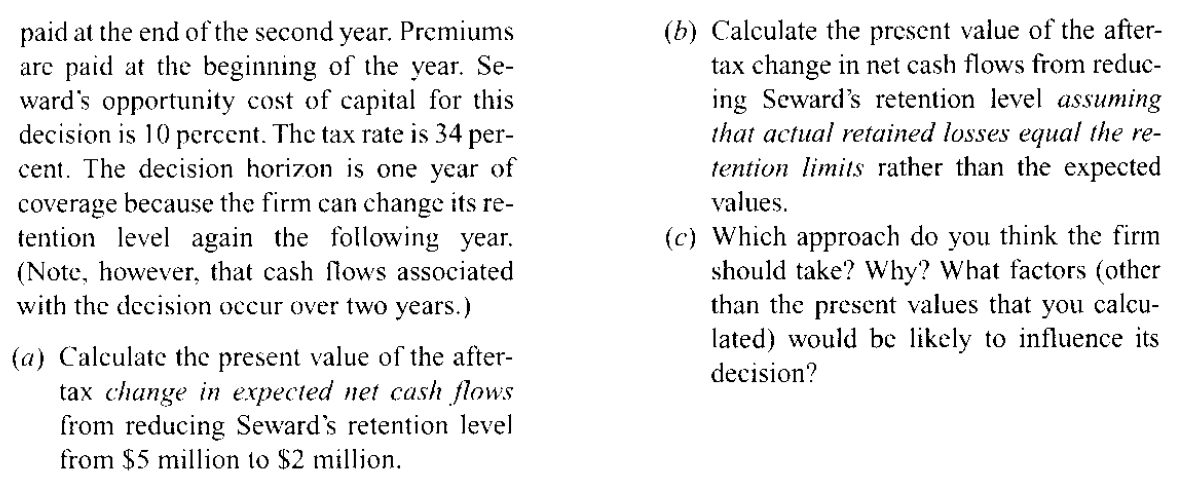

5. Seward Go-Carts has annual sales of $150 million with an expected profit of $5 mil- lion. It currently has a retention limit for an- nual liability losses equal to $5 million. The premium for excess insurance coverage above the $5 million retention is $50,000. With the $5 million retention, its expected retained losses (including claims settlement costs) for accidents during the year equal $1 million. Half of all retained losses for acci- dents during the year will be paid at the end of the year; the remaining half will be paid at the end of the next year. If Seward changes its retention level to $2 million, the premium for excess coverage will be $170,000. Its expected retained losses for accidents during the year will drop to $900,000. Again, half of retained losses for accidents during the year will be paid at the end of the year; the remaining half will be paid at the end of the second year. Premiums are paid at the beginning of the year. Se- ward's opportunity cost of capital for this decision is 10 percent. The tax rate is 34 per- cent. The decision horizon is one year of coverage because the firm can change its re- tention level again the following year. (Note, however, that cash flows associated with the decision occur over two years.) (a) Calculate the present value of the after- tax change in expected net cash flows from reducing Seward's retention level from $5 million to $2 million. (b) Calculate the present value of the after- tax change in net cash flows from reduc- ing Seward's retention level assuming that actual retained losses equal the re- tention limits rather than the expected values. (c) Which approach do you think the firm should take? Why? What factors (other than the present values that you calcu- lated) would be likely to influence its decision? 5. Seward Go-Carts has annual sales of $150 million with an expected profit of $5 mil- lion. It currently has a retention limit for an- nual liability losses equal to $5 million. The premium for excess insurance coverage above the $5 million retention is $50,000. With the $5 million retention, its expected retained losses (including claims settlement costs) for accidents during the year equal $1 million. Half of all retained losses for acci- dents during the year will be paid at the end of the year; the remaining half will be paid at the end of the next year. If Seward changes its retention level to $2 million, the premium for excess coverage will be $170,000. Its expected retained losses for accidents during the year will drop to $900,000. Again, half of retained losses for accidents during the year will be paid at the end of the year; the remaining half will be paid at the end of the second year. Premiums are paid at the beginning of the year. Se- ward's opportunity cost of capital for this decision is 10 percent. The tax rate is 34 per- cent. The decision horizon is one year of coverage because the firm can change its re- tention level again the following year. (Note, however, that cash flows associated with the decision occur over two years.) (a) Calculate the present value of the after- tax change in expected net cash flows from reducing Seward's retention level from $5 million to $2 million. (b) Calculate the present value of the after- tax change in net cash flows from reduc- ing Seward's retention level assuming that actual retained losses equal the re- tention limits rather than the expected values. (c) Which approach do you think the firm should take? Why? What factors (other than the present values that you calcu- lated) would be likely to influence its decision








